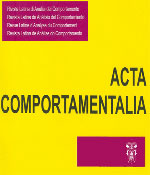Interaction of type of training and type of matching-response in transfer in a second-order conditional discrimination
Main Article Content
Abstract
The present study evaluated the interactive effects of training type (observational versus instrumental) and response type (verbal versus nonverbal) to the transfer and maintenance of a second-order conditional discrimination. Sixteen male and female university students were randomly assigned to four experimental groups. The subjects in two groups received two phases of instrumental training and two transfer tests, the latter with verbal matching responses in one group and nonverbal matching responses in the other. The subjects in the two remaining groups received two phases of observational training and two transfer tests, the latter with verbal matching responses in one group and nonverbal matching responses in the other. The results showed high percentages of correct responding during acquisition and maintenance in virtually all subjects. However, only the subjects using verbal matching responses showed a high level of transfer. These results are discussed in terms of the interaction between verbal descriptions and the instructional properties of second-order stimuli.
Downloads
Article Details

<a rel="license" href="http://creativecommons.org/licenses/by-nc-sa/4.0/"><img alt="Licencia de Creative Commons" style="border-width:0" src="https://i.creativecommons.org/l/by-nc-sa/4.0/88x31.png" /></a><br />Este obra está bajo una <a rel="license" href="http://creativecommons.org/licenses/by-nc-sa/4.0/">licencia de Creative Commons Reconocimiento-NoComercial-CompartirIgual 4.0 Internacional</a>.
